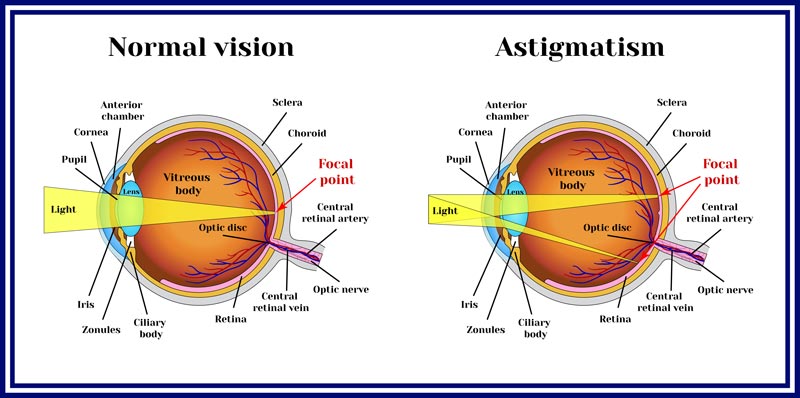Astigmatism
Astigmatism is a common eye condition that’s easily corrected by eyeglasses, contact lenses, or surgery. Astigmatism is characterized by an irregular curvature of the cornea. This is one type of refractive error. Astigmatism occurs in nearly everybody to some degree. For significant curvature, treatment is required.
A person’s eye is naturally spherical in shape. Under normal circumstances, when light enters the eye, it refracts evenly, creating a clear view of the object. However, the eye of a person with astigmatism is shaped more like a football or the back of a spoon. For this person, when light enters the eye it is refracted more in one direction than the other, allowing only part of the object to be in focus at one time. Objects at any distance can appear blurry and wavy.
What Causes Astigmatism?
What Are the Symptoms of Astigmatism?

How is Astigmatism Diagnosed?
Your optometrist can diagnose astigmatism with a thorough eye exam. It may occur with other refractive errors such as myopia (nearsightedness) and hyperopia (farsightedness). Unfortunately, astigmatism often goes undetected in school-age children.
Because astigmatisms may increase slowly, you should visit your optometrist or ophthalmologist whenever you notice significant changes in your vision. Optometrists are trained specifically to examine the general health of the eyes and prescribe eyeglasses and contact lenses. Ophthalmologists provide total eyecare, including exams, diagnosis, and treatment of disease through medication and surgery.
How is Astigmatism Treated?
- Corrective lenses (eyeglasses or contact lenses).
For astigmatism, special corrective lenses called toric lenses are prescribed. Toric lenses have greater light bending power in one direction than the other. After performing various tests, your eye doctor will determine the ideal toric lens prescription for your astigmatism. - Refractive surgery.
Another method for correcting astigmatism is by changing the shape of the cornea through refractive or laser eye surgery. While there is more than one type of refractive surgery, specific treatments are recommended on an individual basis.Refractive surgeries require healthy eyes that are free from retinal problems, corneal scars, and any eye disease. As technology progresses, it is becoming more and more important that you explore all options and possibilities before deciding which refractive surgery and treatment is right for you.


